cuisine is a diverse and flavorful mix of spices, herbs, and vegetables. One dish that exemplifies this culinary richness is the vegetable soup. It’s a hearty and filling food made with an assortment of fresh vegetables, meat, or fish stock, and spiced to perfection.
In this article, we will explore four unique types of vegetable soup recipes that are sure to tantalize your taste buds. Each recipe has its own distinct flavor profile and cultural significance, making it a must-try for anyone interested in experiencing the best of cuisine.
Whether you’re looking for something spicy, savory, or sweet, there is a vegetable soup recipe out there that will satisfy your cravings. So sit back, relax, and get ready to embark on a delicious journey through some of Nigeria’s most beloved dishes!
4 Unique Types Of Vegetable Soup Recipes
Type 1: Efo Riro – A Yoruba Vegetable Soup Made With Spinach, Assorted Meats, And Smoked Fish
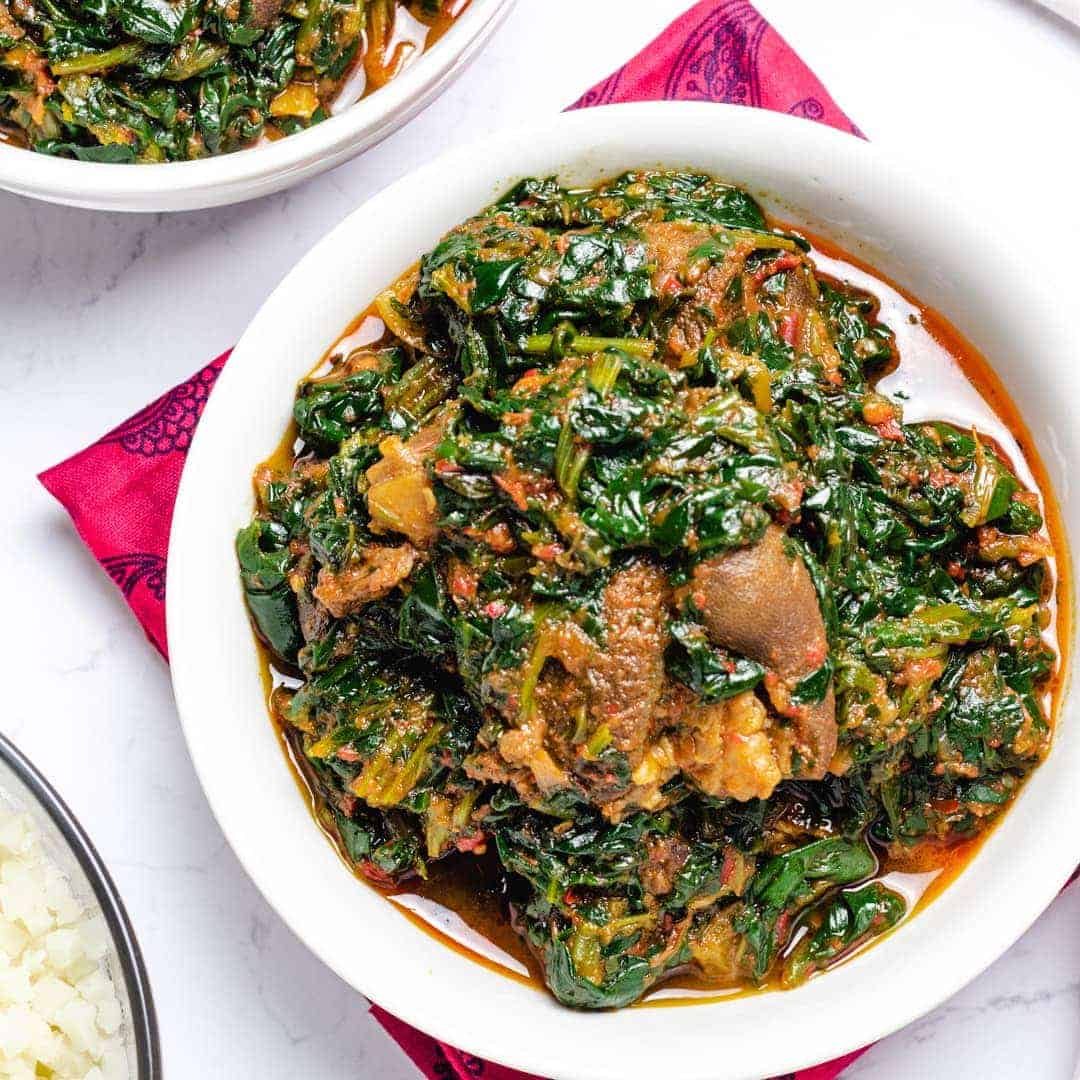
Looking for a hearty and flavorful vegetable soup recipe? Look no further than efo riro! This traditional Yoruba dish is made with spinach, assorted meats, and smoked fish, creating a satisfying meal that’s perfect for any occasion.
Efo riro starts with a base of onions, tomatoes, and peppers. From there, you’ll add in your choice of assorted meats – anything from beef to chicken to goat can work well here. The meat is cooked until tender before being combined with plenty of fresh spinach leaves. Finally, smoked fish is added to the mix for an extra layer of smoky flavor.
The result is a rich and savory soup that’s bursting with complex flavors. Serve it over rice or some homemade fufu for a complete meal that satisfies even the heartiest appetite. And if you’re looking for something truly authentic, be sure to use palm oil instead of regular cooking oil – it adds a distinctive earthy taste that really makes this dish shine.
So whether you’re new to cuisine or just looking for a delicious new way to enjoy vegetables, give efo riro a try today. With its bold spices and hearty ingredients, this Yoruba vegetable soup is sure to become one of your go-to recipes in no time at all. And next up on our culinary journey through Nigeria: edikaikong – another classic soup from the Efik and Ibibio tribes that are full of bright flavors and diverse textures.
Type 2: Edikaikong – A Soup From Akwa Ibom Made With Pumpkin Leaves, Water Leaves, And Various types of meat
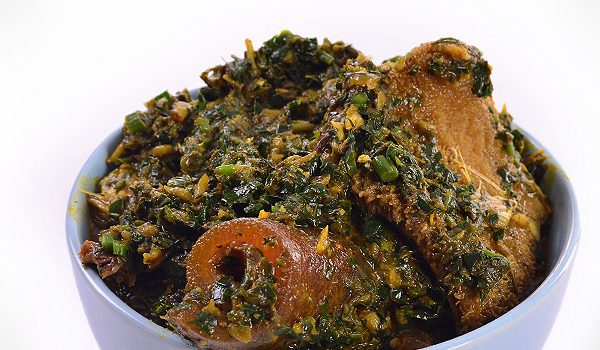
When it comes to vegetable soups, the options are endless. One unique soup that stands out is Edikaikong. This soup originates from Akwa Ibom, and its recipe includes pumpkin leaves, water leaves, and various types of meat.
To make this delicious soup, you will need a combination of fresh ingredients such as smoked fish, cow skin (pomo), assorted meat, crayfish, and palm oil. The key to making this tasty dish lies in knowing how to prepare the vegetables properly before adding them to the pot. Once cooked correctly, they will give your meal an authentic taste that’s hard to beat.
Edikaikong is more than just a soup; it’s an expression of culture and tradition. It has been passed down from one generation to another within these two tribes for centuries. Its rich history makes it even more special as it not only represents its cultural heritage but also celebrates its culinary expertise.
As we continue our exploration of vegetable soup recipes, let us move on to Ofe Ugwu – a vegetable soup from the Igbo tribe.
Type 3: Ofe Ugu – Igbo Vegetable Soup Recipe
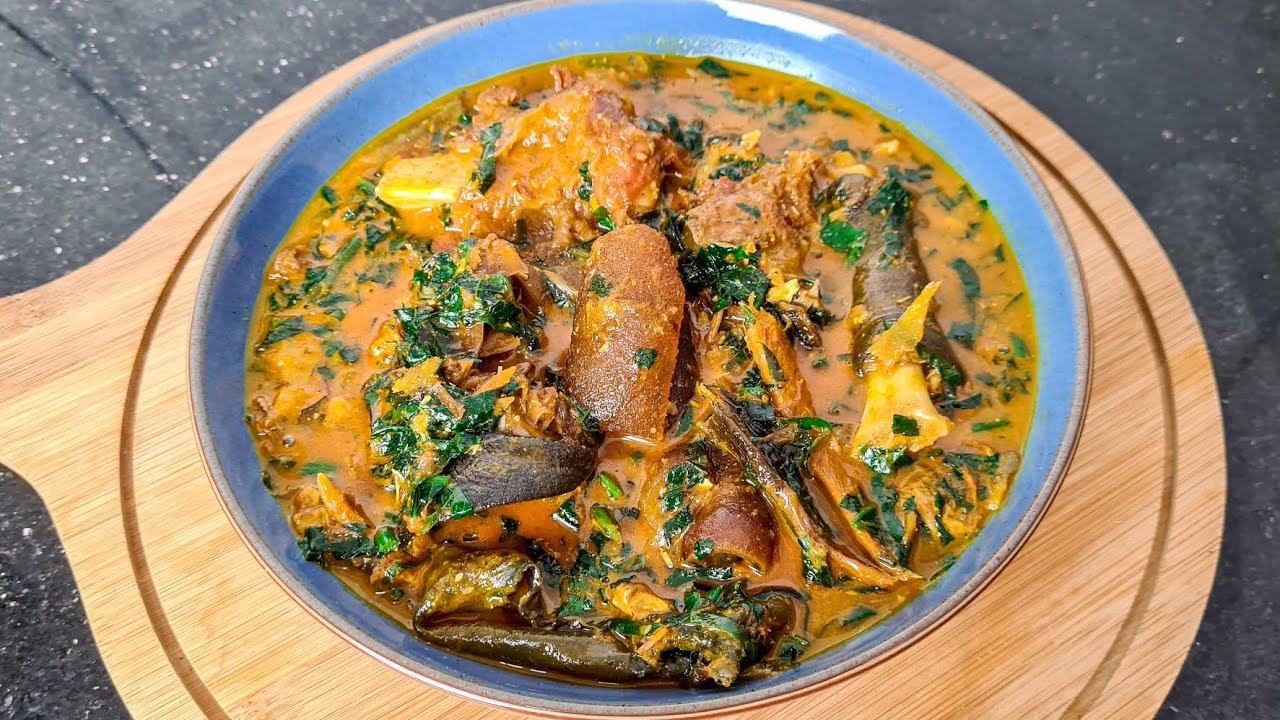
The pumpkin leaf used to make this vegetable soup is called “Ugwu.” This vegetable soup is loaded with pleasing taste and flavour. In the eastern part of Nigeria, this method of cooking vegetable soup is particularly popular. To make ofe ugu (Igbo vegetable soup) follow these steps:
1. Get your stock fish, cow feet, Shaki, beef, and kpomo from the market. Wash each item thoroughly to remove any dirt or sand from the body.
2. Put all of your washed meats in a pot and put water into the pot so that it is at the same level as your meat. Put in your salt, onions, and spice cubes to season the food properly.
3. Ensure sure the meats are cooked through by determining if they are tender and whether the liquid (beef stock) has significantly decreased.
4. After the meat is well cooked, add the palm oil and simmer for about 7 minutes to fully mix the oil into the beef stock.
5. Add the dried fish, then add the cocoyam paste to the soup to thicken it. Add your crayfish and taste it to see if it needs more seasoning.
6. Chop, and wash your ugwu leaves neatly before adding them. After letting it simmer for approximately 5 minutes, turn off the heat and your delicious Ofe Ugo is ready to be served.
Type 4: Afang Soup – Efik/ Ibibio Vegetable Soup Recipe)
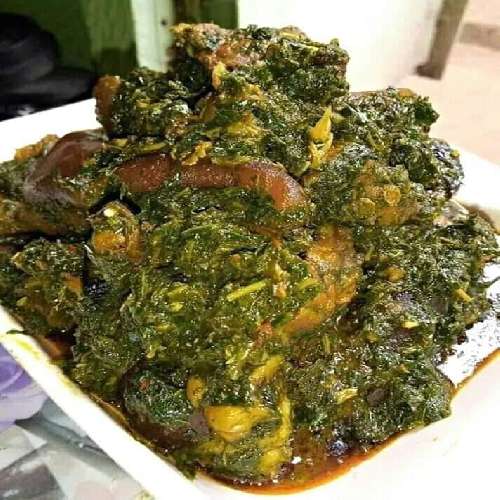
This mouthwatering vegetable soup is a native of Ibibio, an Efik-speaking region of Nigeria. Water and Afang leaves are used in their preparation. This is a recipe for afang soup:
- Season your meat with salt, pepper, and seasoning cubes in a big saucepan.
- Put water in a pot and cook the stockfish head, and cow skin, until everything is soft. At this time, the meat would have absorbed practically all of the stock, leaving only a little amount.
- After selecting, washing, and chopping your water leaves, coarsely shred your afang leaves in a blender or you can locally pound it in your mortar.
- To the saucepan with the mixed meat, add the smoked fish, periwinkle, and the remaining water. Season with crayfish.
- Boil for approximately five minutes.
- After adding your palm oil, boil it for around 7 minutes. And your soup is ready.
As you can see, there are endless possibilities when it comes to preparing vegetable soup. Whether you prefer it spicy or mild, with plenty of meat or mostly vegetables, there is sure to be a version out there that suits your taste buds perfectly.
In summary, if you haven’t tried vegetable soup yet, then I highly recommend giving it a go. Not only is it delicious but it’s also a great way to explore cuisine at its finest. So next time you’re looking for something different and exotic to try out? why not give this hearty and flavorful soup a chance? Your taste buds will thank you!
The best way to prepare Edikikond soup.
Frequently Asked Questions
What Is The History Behind These Vegetable Soups?
Have you ever wondered about the history behind vegetable soups? These delicious and unique dishes have been enjoyed bys for centuries, but their origins are not well-known. However, we can piece together some information to understand how these soups came to be.
One theory is that the use of vegetablesn cuisine dates back to pre-colonial times. Vegetables such as okra and spinach were commonly grown and used in meals, with different tribes having their own methods of preparation. Over time, these ingredients were combined with other local spices and proteins to create the flavorful soups we know today.
Another possible explanation for the popularity of vegetable soups is that they are a reflection of the country’s diverse cultural influences. The combination of indigenous ingredients with those introduced by traders or colonizers resulted in new culinary traditions being born. Today, many households continue to pass down family recipes for soup making, ensuring that these dishes remain an integral part of their heritage.
In conclusion, while there may not be one definitive answer to the question of how vegetable soups came into existence, it is clear that they hold a special place in the country’s culinary identity. Whether made with egusi seeds, bitter leaf, ugu leaves, or any other combination of vegetables and spices, these soups represent something more than just a meal. they embody a rich history and culture.
Are There Any Unique Cooking Techniques Used In Making These Soups?
As you explore the various types of vegetable soup recipes, you may wonder: are there any unique cooking techniques used in making these soups? The answer is a resounding yes! Each type of soup has its own distinct methods and ingredients that set it apart from the others.
For example, Efo Riro requires a lot of chopping and blending to achieve its signature texture. The vegetables must be finely chopped before being blended into a puree with tomato paste and peppers. This puree is then added to the stock along with meat or fish, creating a rich and flavorful base for the soup.
In contrast, Edikang Ikong involves layering ingredients in a specific order to create layers of flavor. First, palm oil is heated until hot, then onions are sauteed until golden brown. Next comes ground crayfish and pepper, followed by sliced water leaves and pumpkin leaves. Finally, meat or fish is added to complete this delicious dish!
As you can see, each type of vegetable soup recipe has its own unique cooking techniques that make it special. Whether you’re trying your hand at Egusi Soup or Bitterleaf Soup, take some time to learn about the traditional methods used in preparing these dishes. Who knows what tasty surprises await?
Are There Any Regional Variations In The Ingredients Used In These Soups?
When it comes to vegetable soups, there are several variations depending on the region. While some ingredients may be common across different types of soup, others may differ based on where they’re made.
For instance, in the south-south part of Nigeria, “banga” or palm fruit is a popular ingredient used in making their version of vegetable soup. This ingredient gives the soup its characteristic deep red color and unique flavor that’s hard to find elsewhere.
In contrast, the Yoruba people from southwestern Nigeria make their own version called “efo riro”. They use fewer spices but add more leafy vegetables like spinach or kale to create a thicker consistency.
Northerns have their share of vegetable soups too – one such example being Miyan Kuka which is made using Baobab leaves and dried okra powder with meat as the protein source.
The Igbo tribe from southeastern Nigeria also has its variation called Ofe Onugbu (Bitter Leaf Soup), which features bitter leaves as the main ingredient along with meats like goat or beef for added flavor.
It’s worth noting that even within these regions, there can be further variations depending on individual preferences or the availability of ingredients at any given time. However, what remains constant across all versions is the emphasis on fresh produce and natural herbs/spices to enhance flavor without compromising nutrition.
In summary, regional differences play an essential role in creating diverse vegetable soups each with its unique taste and characteristics dependent upon available resources and cultural influences rather than uniformity. As such, there’s no right or wrong way to make these soups. only differing interpretations that reflect local traditions passed down through generations.
Can These Soups Be Made Vegetarian Or Vegan?
As coincidence would have it, all four types of vegetable soup recipes are traditionally made with meat or fish. However, that doesn’t mean they cannot be adapted for vegetarians or vegans.
To make these soups vegetarian-friendly, simply omit the meat and replace it with a plant-based protein such as tofu or tempeh. By making simple substitutions and additions, anyone can enjoy the delicious flavors of vegetable soup recipes while still sticking to their dietary preferences.
What Are Some Common Side Dishes Served With These Soups?
Now that we have explored the various types of vegetable soups and their recipes, let’s talk about some common side dishes served with these scrumptious delights. As you may already know, cuisine is all about hearty meals accompanied by a plethora of sides to enhance the overall taste experience.
First up on our list is the classic “swallow.” No, it’s not something you do with your food; swallow refers to a type of starchy dough made from cassava, plantain, or yam flour. It’s dense and filling, making it perfect for sopping up all that delicious soup broth.
Another popular side dish is jollof rice or white rice. This savory rice dish cooked with tomatoes, onions, peppers, and spices has become a staple across many African countries. The addition of this flavorful rice will complement any vegetable soup by bringing out its unique flavors while adding an extra level of depth to your meal.
To conclude: There are endless possibilities when it comes to pairing sides with vegetable soup; however, these three options mentioned above are tried-and-tested classics that never disappoint. So next time you’re whipping up one of these delightful soups in your kitchen, don’t forget to serve them alongside some delicious swallows or rice.
Conclusion
In conclusion, vegetable soups offer a diverse range of flavors and ingredients that are unique to different tribes in the country. Efo Riro is a great option for spinach lovers who enjoy smoked fish and assorted meats. Edikaikong offers a rich taste with pumpkin leaves and water leaves combined with various types of meat, while Ofe Ugwu provides an enticing flavor.
Overall, these four types of vegetable soup provide an incredible burst of flavor that can be enjoyed by all food enthusiasts around the world. So why not try something new? Go ahead and make one of these delicious soups today! It’s time to add some spice to your life and let your taste buds experience something ‘lit’ (anachronism) like never before!


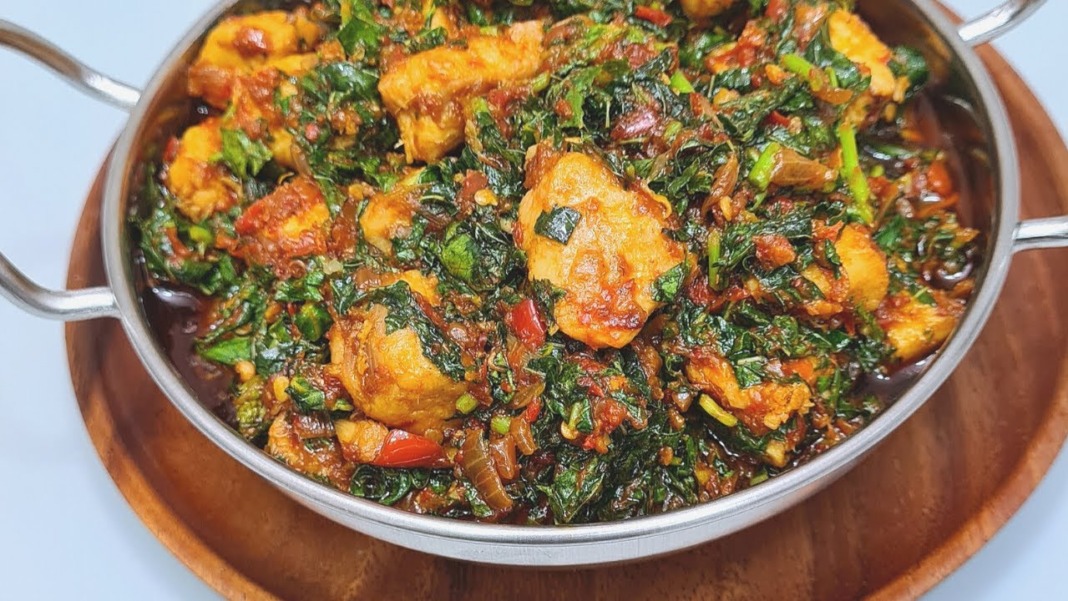

Nice